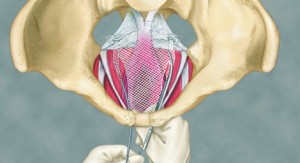After experiencing trauma—like surgery, infections, or inflammation—the body forms internal scars, called adhesions, as it heals. Sexual abuse, injury or a fall on the backside or hips can all prompt adhesion formation and contribute to chronic pelvic pain as well as conditions like colitis, gastritis, perforated ulcer, or appendicitis.
Pelvic inflammatory disease, STDs, endometriosis, surgery to correct conditions such as uterine prolapse, and bladder, vaginal or yeast infections all incite the same bodily response—adhesions. These adhesions can result in chronic pain and pelvic dysfunction. Adhesions are like internal scars, forming strong bonds between tissues that should be free to move independently. They can restrict movement and create a pulling effect that only irritates the area more.
Surgery Causes Adhesion Formation

Transvaginal mesh is a medical device that is used to repair common pelvic floor disorders in women. It is implanted through the vagina to improve continence issues and/or provide support for prolapsed organs.
Surgery to correct uterine prolapse and other forms of pelvic organ prolapse or stress urinary incontinence can cause adhesions to form. In addition, hysterectomy, C-section, and childbirth can also cause adhesions.
Surgery has been cited as the primary cause of adhesions, with between 55 to 100 percent of women developing adhesions after pelvic surgery. While revision surgery can be performed to remove adhesions, the body creates new adhesions to heal itself from additional surgery.
Complications
Because adhesions can form like a rope between distant bodily structures, seemingly inexplicable pain in areas distant from the trauma or infection may result. When adhesions form at the reproductive organs—fallopian tubes, ovaries, and uterus—they can cause pain and hinder reproductive function. Adhesions have been cited as a major cause of infertility.
When the cervix is adhered to, adhesions can cause stenosis of the cervix or fibrosis, fertility is jeopardized, and sex can be painful. The adhesions can form on the ligaments that keep the cervix aligned, pulling the cervix out of position. Everyday movements can exacerbate the problem, perpetuating the cycle of inflammation and adhesion formation.
Sometimes, adhesions can completely obstruct the intestines, causing a life-threatening condition called small bowel obstruction.
Treatments
Doctors may prescribe painkillers to treat post-surgical chronic pelvic pain resulting from conditions such as uterine prolapse. This may help with pain but does not treat adhesions. If patients do not respond to pain management medications, surgery to remove the adhesions may be recommended.
Lysis of adhesions, which can be performed via open surgery or less-invasive laparoscopy, is the surgical removal (cutting or burning) of adhesions. This can be effective, although it is usually not a permanent fix because the body will form adhesions again to heal itself. Follow-up surgery is probable.
Manual therapy, performed by some pelvic physical therapists, involves applying pressure specifically to affected areas—muscles, fascia, organs, nerves, ligaments, and tendons. The intent of this therapy is to break down adhesions and restore function. This technique often identifies adhesive pain patterns for the therapist to focus on.
The Wurn Technique is a total-body treatment system that employs over 200 techniques, developed over 20 years by Larry Wurn, LMT, and Belinda Wurn, PT. In attempts to treat Belinda’s chronic pain, the Wurn method proves that with sustained pressure applied over time, adhesions can be detached or dissolved. Patients, including Belinda, have experienced pain relief, and improved function, mobility, and flexibility.
Linda Grayling is a writer for Drugwatch.com. She enjoys keeping up with the latest news in the medical field.
Related Content:
- Severe Post-Surgical Adhesions – Patient Success Story
- Abdominal and Pelvic Adhesions: Post-surgical Adhesions
- Post-Surgical Pain and Adhesions
- Treatment of Adhesions Caused by Transvaginal Mesh: Guest Post by Drugwatch.com
- Video Testimonial – A Mother’s Journey to Recovery: Small Bowel Obstruction





















